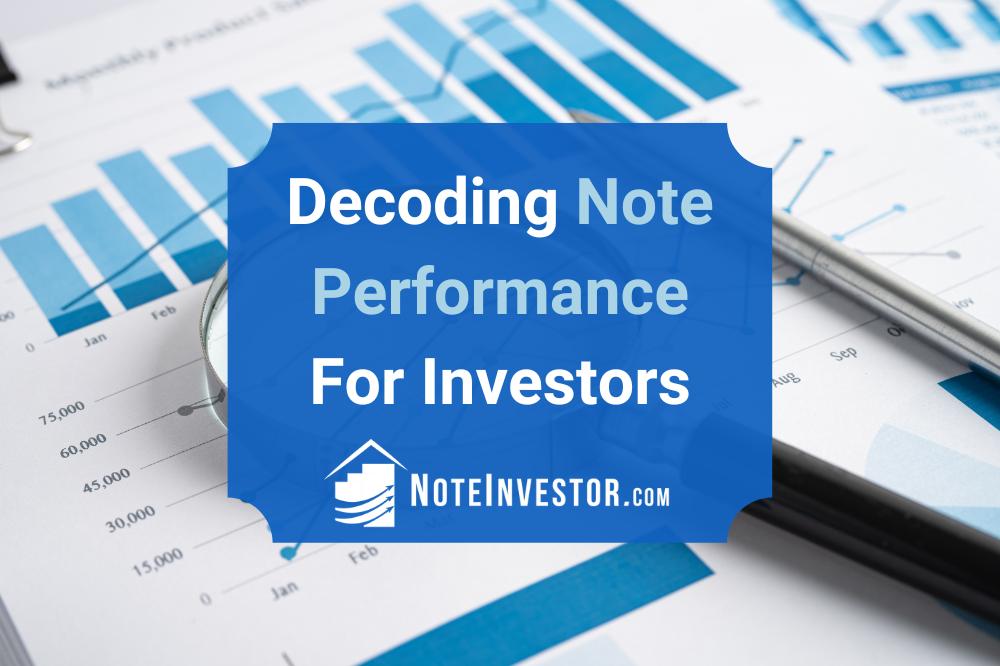You know the term, “there are plenty of fish in the sea?” Well, the same is true for note investing.
There is a note out there for all types of investors. With over $100 billion of inventory, there are likely multiple notes out there.
So if there are plenty of notes, it really is all about finding which notes work for your goals.
Before you decide whether you want to invest in notes secured by single-family homes, land, or commercial property, we need to address something else.
Note performance.
There are really two main categories when it comes to note performance – performing and non-performing – and that middle ground occupied by sub-performing and re-performing notes.
Factors of Note Performance For Investors
When note investors look at deals, we look at a number of different factors to determine value. These include:
- Note Rate (Interest Rate)
- Down Payment
- Borrower’s Credit
- Note Terms
- Property Value
- Paperwork
- Payment History
That last one – payment history – is what determines a note’s performance. It’s a fancy way of answering, “Is the buyer making payments on time?” Not only does it affect value, it can change whether or not you even want to purchase.
Understanding Note Performance Categories
When it comes to performance, there are two main categories: performing and non-performing. But, there are also two categories that are often referenced that are somewhere in between: sub-performing and re-performing.
Performing Notes
This is where most note buyers do business.
A performing note is a note that a buyer is reliably and consistently making their payments. They aren’t behind and are right on schedule. This timely history shows investors that they can rely on those monthly payments to continue.
And for note sellers, it can get them the most for their note. That is especially true when there is a verified payment history. That can be done by using a third party to collect and record payments. Or, if you collect the payments directly, keep meticulous and verifiable records of the payments (think bank statements versus a written list).
Non-Performing Notes
The opposite of performing notes are non-performing loans (also called NPNs or NPLs). These are notes where the buyer is behind on payments or has stopped paying altogether. While any missed payments can be a default to the terms, a note usually gets classified as non-performing when it hits 90+ days past due.
Along with missing payments, a borrower might also be in default for letting property insurance lapse or getting behind on paying real estate taxes.
Many investors find non-performing notes to be a headache. But, others see opportunity.
For starters, investors can purchase non-performing notes at a more significant discount. And experienced note buyers know that there are options. You can work with the buyer on a plan to get back on track, modify the note to make payments affordable to their current circumstances, negotiate a deed in lieu of foreclosure, or when necessary start the foreclosure process.
It’s all about what works for the investor’s goals and knowledge.
Investing in non-performing paper takes some advanced knowledge. Each state has specific laws, timelines, and notice requirements for collecting payments or pursuing foreclosure. There are also statute of limitations laws that might apply which can limit the time allowed to collect. When buying notes, especially NPNs, it’s important to use a licensed servicing company and the help of an experienced attorney.
Re-Performing Notes
One smaller group of performing notes is re-performing notes (RPLs).
These re-performing notes were once considered nonperforming with a buyer missing payments but are now repaying again. Whether from circumstances getting better or working with the note holder, they have gotten back on track and are making payments.
This category has no set time, and the term often gets tossed around freely. We’ve seen notes marketed as current and re-performing where a loan modification was just signed on a seriously delinquent note and the buyer has only made one payment. This hardly seems as secure as a note that was behind and has been paying consistently each month for 12 or more months.
As an investor, it’s important to perform your due diligence to verify the current payment history, how long the payer has been paying again, and if it’s something you are comfortable investing in.
Sub-Performing Notes
Sub-performing notes are somewhere in between performing and non-performing notes.
They may have just one payment missing or they might have made 10 out of the last 12 payments. As a note holder, this is an excellent time to have your servicing company reach out and connect with the buyer. It’s not the time to sit on your hands. Before you know it, sub-performing turns into non-performing.
Choosing the Note Performance that Works for You
While performing notes are ideal for their confidence, investors can find opportunities in all types of notes — and more significant discounts. It’s all about figuring out what works for your knowledge level, experience, and goals and then pricing according to risk and return.
Are you interested in investing in notes and learning how to calculate values and yields? Check out our Calculating Notes Master Class.


